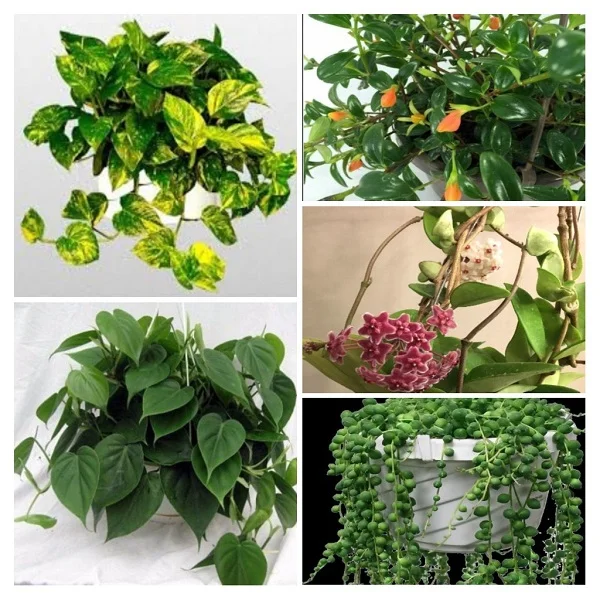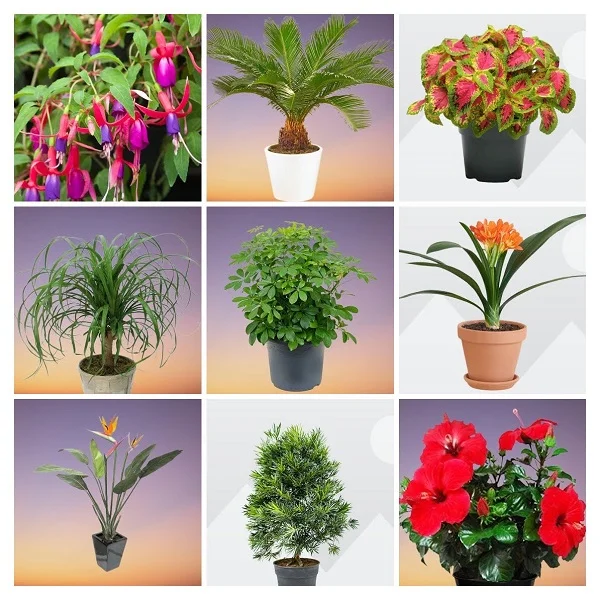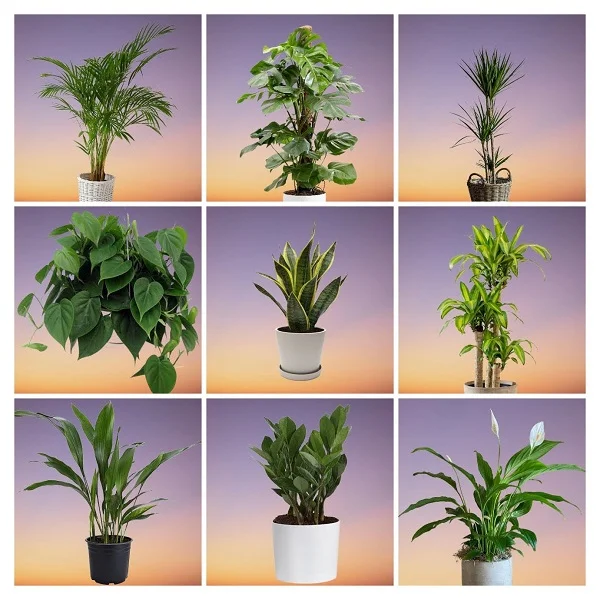Fuchsia Plant (Fuchsia hybrida) Care Indoors and Common Problems with Remedies
Some links in this post may be affiliate links
Fuchsia hybrida blooms in bright light away from direct sunlight, average warmth, moderate humidity and consistently moist, fertile, well-drained, all purpose soil coupled with fortnightly feeding in the growing season.
Fuchsia Plants are some of the most popular flowering plants whose blooms are showy sepals and petals which may or may not be the same color, may be single, semi-double, double bells or clustered blooms on soft-stemmed bushes.
Fuchsias may be grown as a bush or in a hanging basket for the trailing types. They are some of the best flowering plants for hanging baskets and require regular training and pruning to keep them free-flowering and shapely.
They do not like sudden changes in growing conditions therefore maintain the right growing conditions as much as possible. Avoid moving the plant during flowering and bud formation as it can result in the dropping of buds and flowers.
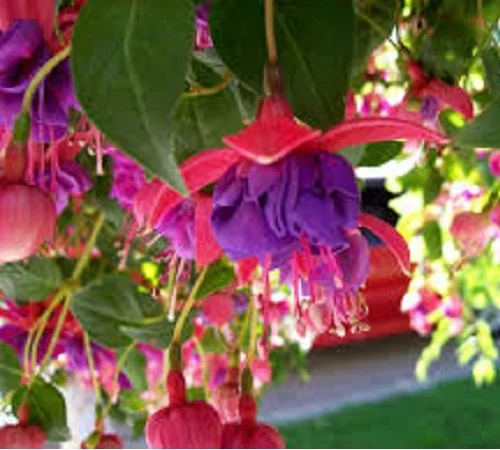
Botanical name: Fuchsia hybrida
Family: Onagraceae
Common name: Fuchsia
Origin
Majority of Fuchsias are native to South America, Central America and Newzealand. Fuchsias are named after the German botanist Leonhart Fuchs. Most of the Fuchsias under cultivation now are hybrids. Fuchsia hybrida is a hybrid between Fuchsia magellanica and Fuchsia fulgens.
Toxicity
Fuchsia hybrida are non-toxic to humans and pets. The fruits and flowers can be eaten with no ill-effects.
Fuchsia hybrida Care Indoors
Fuchsias (Fuchsia hybrida) blossom in bright indirect light (filtered light), average warmth of 15-230C, moderate humidity of 50-55% and consistently moist, rich, well-drained, all purpose soil coupled with fortnightly feeding during the growing season.
Fuchsia require regular pruning to keep the plant neat as well as encourage a bushy growth. Repotting is only necessary when the plant is extremely pot-bound as it blooms best when root-bound. Keep reading for more on these growing conditions.
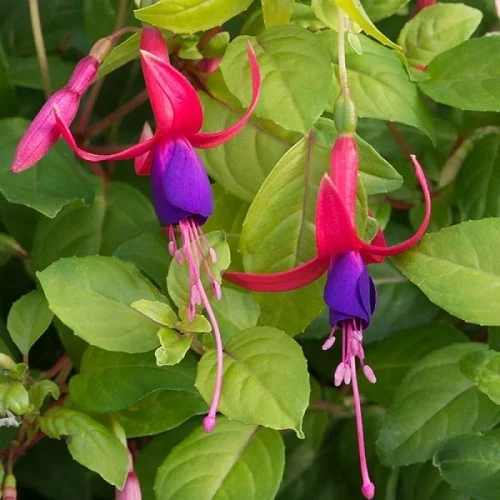
Light Requirements
Fuchsia grows best in bright light; a spot infront of a large window is ideal for this plant. Keep it away from direct sunlight to avoid scorching.
Where the light is too low, it will not bloom. Therefore, if the natural lighting is not adequate, you may instal a grow light to supplement it. Check out these full spectrum grow lights on Amazon.
Rotate the pot regularly to ensure that the plant receives light on all sides for even growth and prevent leggy growth.
Watering
Water Fuchsia Plant liberally during the growing season and allow the soil to top 1-2 inches of soil to dry out between waterings to keep the soil consistently moist.
Reduce watering during the cold period as growth is minimal at this time but do not allow the soil to dry out completely.
Confirm that the pot has a drainage hole and that the soil is free-draining to prevent the soil from getting soggy as it can lead to root-rot and eventual loss of the plant.
Temperature and Humidity
Average warmth between 15-230C is ideal for Fuchsia. Keep it away from cold and hot drafts to avoid sudden changes in temperature which can cause reduced growth and leaf drop.
Average room humidity of 50-55% is ideal for Fuchsia. However, if the air is too dry, set the pot on a wet pebble tray or use a cool mist humidifier to increase humidity. Read more on how to raise humidity for houseplants.
Fertilizer
Feed Fuchsia with a balanced, water-soluble fertilizer every 2-3 weeks during the growing season. Withhold feeding in the cold season as growth is minimal and it can lead to fertilizer burn.
Potting Soil
The best soil for Fuchsia Plant should be rich in organic matter and free-draining to prevent it from getting soggy while providing the required nutrients. Most all purpose potting mixes are ideal for this plant.
Repotting
Repot Fuchsia during the growing season only when the plant is extremely pot-bound as it blooms more when pot-bound. Do not repot a plant that is in flower as the repotting shock can shorten the flowering period.
Use a pot 1 size larger and one that has a drainage hole to prevent the soil from getting soggy as it can result in root-rot and the eventual death of the plant. Take a look at these self watering planters with drainage hole on Amazon.
The large Fuchsia plants can be top-dressed annually by replacing the top 3-4 inches of soil with fresh soil.
Pruning
Pruning Fuchsia is easy. Remove dead flowers and leaves to maintain the plant neat and discourage pest and disease infestations. Pinch off the growing tips to encourage compact growth.
After flowering, cutback the stems with a sharp, clean pair of pruning scissors to rejuvenate growth and prevent the plant from becoming leggy. Place the plant in a cool place and reduce watering until new growth emerges.
How to promote flowering in Fuchsia Plant
Fuchsia Plant requires a resting period during the cold season, about 6-8 weeks. Place the Fuchsia in a cool place, about 100C.
Decrease watering to maintain the soil barely moist and withhold feeding during this cold period (6-8 weeks).
After this cold treatment, put back the plant in a brightly lit place and continue with normal routine care.
The cold treatment will promote flowering in Fuchsia as this treatment mimicks its native growing conditions.
Propagation
Fuchsia Plants can be propagated at the beginning of the growing season from stem-tip cuttings which can be rooted either in water or in soil.
Read more on how to propagate Fuchsia Plants from stem-tip cuttings (2 Fuchsia Propagation Methods)
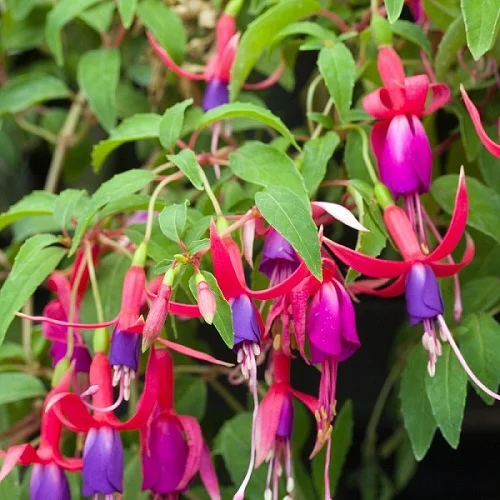
Fuchsia hybrida Problems
Fuchsia Plants (Fuchsia hybrida) problems include flowerbud drop, leaf drop, poor flowering, leaf spots, pests and diseases among others. Keep reading for more on these problems, their remedies and solutions.
Pests
The common pests in Fuchsia Plants are spider mites and whiteflies. Isolate the affected plant to prevent spread to other plants and treat it appropriately for the pests.
Brown leaf spots with yellow margins
Brown leaf spots with yellow margins in Fuchsia Plant are an indication of leaf spot disease which is enhanced by overwatering in the cold season. Reduce watering in the cold season to maintain the soil slightly moist as growth is minimal at this time. Make sure that the pot has a drainage hole and that the soil is free-draining to prevent the soil from getting soggy.
Dropping flowerbuds
There are four possible causes of flowerbud drop in Fuchsia. One possible cause of flower bud drop is incorrect watering; either underwatering or overwatering. Maintain the soil consistently moist during the growing season but never let it be soggy.
Lessen the watering in the cold period to keep the soil slightly moist but do not let it dry out completely. Always ensure that the pot has a drainage hole to prevent the soil from getting soggy. Learn more on how to water indoor plants the right way.
The second possible cause of flowerbud drop in Fuchsia is low light. The plant requires bright light away from direct sunlight. Therefore, move it to a brighter spot where it will receive bright light or instal a grow light if the natural light is not adequate. Check out this guide on understanding light for houseplants.
The third possible cause of flowerbud drop in Fuchsia is too much heat due to hot drafts. Keep the plant away from hot drafts like hot air vents, hot surfaces among others and keep it away from direct sunshine to maintain average temperatures of 15-230C. Check out this guide on understanding temperature for houseplants.
The fourth possible cause of flowerbud drop in Fuchsia is moving or turning the pot while the plant is in bud. Avoid moving the plant while in the bud formation stage to prevent bud drop.
Progressive loss of lower leaves
There are two possible causes of progressive loss of the lower leaves in Fuchsia Plant. One possible cause of progressive loss of the lower leaves is underwatering. It prefers consistently moist soil during the growing season and slightly moist in the cold season but never allow the soil ball to dry out completely.
The second possible cause of progressive loss of the lower leaves in Fuchsia is too little light. Move the plant to a brighter spot as it grows best in bright light or instal a grow light where natural light is not adequate.
Sudden leaf drop
Sudden leaf drop in Fuchsia Plant is due to hot dry air which leads to very low air humidity. Set the pot on a wet pebble tray or use a cool mist humidifier to raise humidity.
Poor flowering or no flowering
There are four possible causes of poor flowering or no flowering in Fuchsia Plant. One possible cause of poor flowering or no flowering is underfeeding. Feed the plant every 2-3 weeks during the growing season with a balanced, water-soluble fertilizer but do not feed it in the cold season.
The second possible cause of poor flowering or no flowering in Fuchsia is underwatering. Keep the soil consistently moist during the growing season and slightly moist in the cold season but never let the soil ball dry out completely.
The third possible cause of poor flowering or no flowering in Fuchsia is too little light. Position the plant in a brighter spot where it will receive bright light or instal a grow light where natural light is not adequate.
The fourth possible cause of poor flowering or no flowering in Fuchsia is too high temperatures during the dormancy period. Fuchsia requires a resting period during the cold season (6-8 weeks) to promote flowering. Keep the plant in a cool place and reduce watering during this period.
You liked it? Share on social media.
Related Content
Amazon Associates Disclosure
Homeplantsguide.com is a participant in the Amazon Services LLC Associates Program, an affiliate advertising program designed to provide a means for sites to earn advertising fees by advertising and linking to amazon.com.



